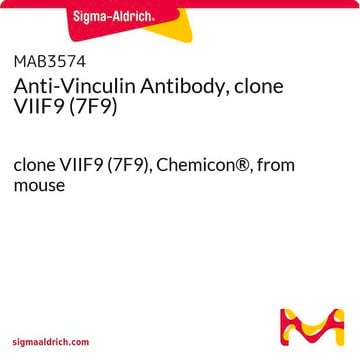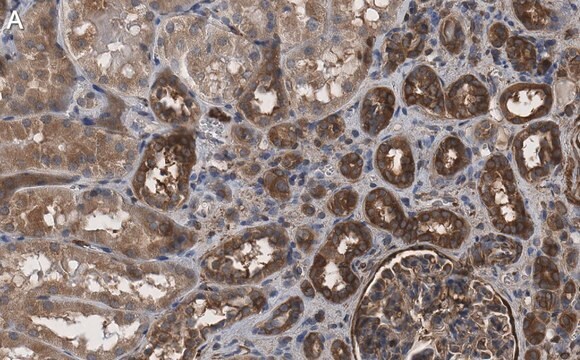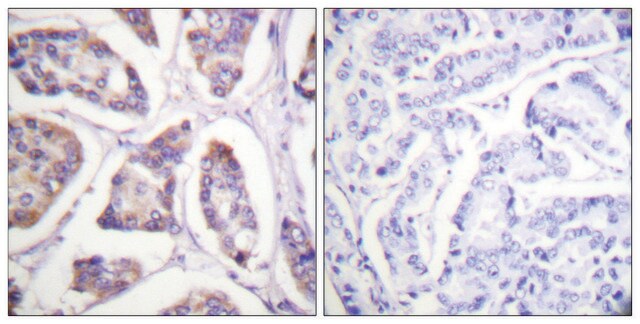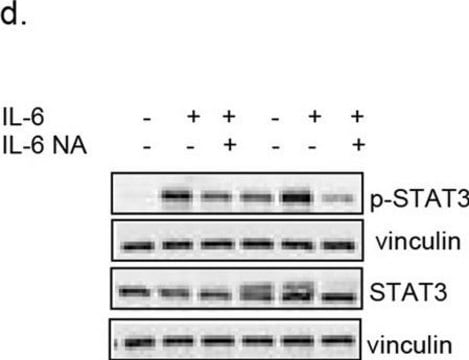There are no available papers that cite using clone VIN-11-5 with Drosophila vinculin. The specific epitope for this antibody has not been mapped. However, there is a paper that maps the epitope binding area of this antibody clone - JBC 266, 8734-8740. 1991, Fusun Kilic, et al. --> "Hence the epitope lies between cysteines 545 and 737." Please see the link below to review this publication:
https://www.sciencedirect.com/science/article/pii/S0021925818315072?via%3Dihub
Wichtige Dokumente
V4505
Anti-Vinculin Antibody
mouse monoclonal, VIN-11-5
Synonym(e):
Vinculin Antibody Sigma, Anti-VCL
Größe auswählen
CHF 432.00
Größe auswählen
About This Item
CHF 432.00
Empfohlene Produkte
Produktbezeichnung
Monoclonal Anti-Vinculin antibody produced in mouse, clone VIN-11-5, ascites fluid
Biologische Quelle
mouse
Qualitätsniveau
Konjugat
unconjugated
Antikörperform
ascites fluid
Antikörper-Produkttyp
primary antibodies
Klon
VIN-11-5, monoclonal
Mol-Gew.
antigen 116 kDa
Speziesreaktivität
bovine, human, chicken, mouse
Methode(n)
indirect immunofluorescence: 1:50 using cultured chicken fibroblasts
microarray: suitable
western blot: suitable
Isotyp
IgG1
UniProt-Hinterlegungsnummer
Anwendung(en)
research pathology
Versandbedingung
dry ice
Lagertemp.
−20°C
Posttranslationale Modifikation Target
unmodified
Angaben zum Gen
human ... VCL(7414)
mouse ... Vcl(22330)
Allgemeine Beschreibung
Spezifität
Immunogen
Anwendung
- western blotting.
- immunofluorescence.[1]
- immunocytochemistry.
Biochem./physiol. Wirkung
Sonstige Hinweise
SAB4200729 Anti-Vinculin antibody, Mouse monoclonal
clone VIN-11-5, purified from hybridoma cell culture
Haftungsausschluss
Sie haben nicht das passende Produkt gefunden?
Probieren Sie unser Produkt-Auswahlhilfe. aus.
Empfehlung
Ähnliches Produkt
Lagerklassenschlüssel
13 - Non Combustible Solids
WGK
WGK 1
Flammpunkt (°F)
Not applicable
Flammpunkt (°C)
Not applicable
Hier finden Sie alle aktuellen Versionen:
Analysenzertifikate (COA)
Die passende Version wird nicht angezeigt?
Wenn Sie eine bestimmte Version benötigen, können Sie anhand der Lot- oder Chargennummer nach einem spezifischen Zertifikat suchen.
Besitzen Sie dieses Produkt bereits?
In der Dokumentenbibliothek finden Sie die Dokumentation zu den Produkten, die Sie kürzlich erworben haben.
Kunden haben sich ebenfalls angesehen
-
Hello! Has it been published or predicted if this antibody will react with Drosophila vinculin? Or, could you provide where in the human vinculin this antibody interacts?
1 answer-
Helpful?
-
Active Filters
Unser Team von Wissenschaftlern verfügt über Erfahrung in allen Forschungsbereichen einschließlich Life Science, Materialwissenschaften, chemischer Synthese, Chromatographie, Analytik und vielen mehr..
Setzen Sie sich mit dem technischen Dienst in Verbindung.
















